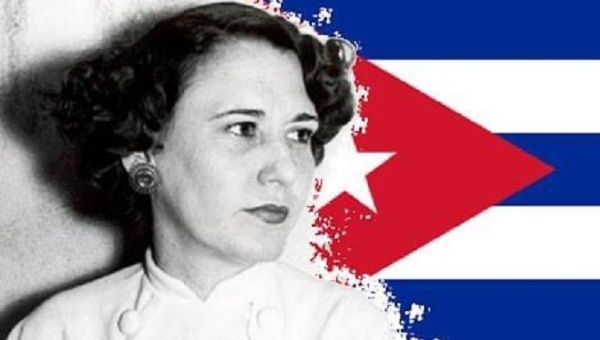

Haydee Santamaría


Haydee Santamaría
In the early hours of July 26, 1953, Fidel Castro and nearly 150 Cuban rebels traveled to the Moncada garrison to capture the barracks and seize the many weapons stored there. They planned for this to be the beginning of the Cuban Revolution to overthrow the Cuban dictator, President Fulgencio Batista.
Batista’s forces ambushed the rebels, however, killing half of them and imprisoning those who survived the attack, including Fidel and Haydée Santamaría.
Although the rebels failed to take hold of the Moncada, it was a turning point that changed the course of Cuban history. It laid the basis for the successful revolution six years later in 1959.
While in prison Fidel wrote his famous decisive thesis: “History will absolve me.” He wrote in lemon juice on napkins that were sneaked out of the prison. Haydée Santamaría wrote out and edited Fidel’s thesis and, with a group of revolutionaries, disseminated the thesis to the Cuban workers. This provided the inspiration that sparked the revolution.
Haydée Santamaría’s brother Abel Santamaría and fiancé Boris Luis Santa Coloma, also imprisoned after the Moncada, were both killed and tortured. Haydée heard her brother’s screams as the prison guards gouged out his eyes.
Batista wanted Haydée Santamaría to divulge Fidel’s whereabouts. To force her to speak, the torturers showed her her brother’s eyes and Boris’ dismembered genitalia. This grotesque act of intimidation, however, did not break her revolutionary strength. She defied her own torturers and remained silent. “If you did that to them, and they didn’t talk, much less will I.”
Santamaría wrote to her mother from prison: “Abel will always be with us. Cuba exists, and Fidel is alive to build the Cuba that Abel wanted.” She said, “Abel is not dead, for to die for your country is to live.”
Launch of the guerrilla war
After being released from prison, Fidel went into exile in Mexico. In November 1956, Fidel and a group of rebels sailed to Cuba on the famous yacht Granma. Batista’s forces ambushed Fidel and his comrades, but those who survived, including Fidel, went to the Sierra Maestra hills to launch a guerrilla struggle.
Santamaría joined the guerrillas after her release from prison. She was in charge of obtaining weapons and resources and fought alongside other heroines such as Celia Sánchez and Vilma Espín.
When later asked about the Moncada, Santamaría said: “I never considered the attack on the Moncada to be a failure. It was different from all the other battles leading to the revolution. It was the first. When Abel, my first son was born, the pain was enough to tear out one’s insides, yet there was also the strength to keep from crying or screaming or cursing. Why? Because a child was coming.
“That was the Moncada. We kept our serenity, because of what we knew was to come from it all. It is only because of the coming of something great that one can stand such grief.” (Moncada, Memories of the Attack that Launched the Cuban Revolution, L. Stuart, 1980)
When talking about the eve of the attack on the Moncada, Haydée recalled: “It was one of the most joyful nights. I could not know what would happen, but I knew that it would be something great. That alone is worth the pain of living. I wondered if I would ever again see the sunshine of my country. I knew that if I didn’t see it that too would be great. . . .
“We tend to say: ‘That happened before,’ or ‘that happened after.’ And that before and that after are before Moncada and after Moncada. After Moncada we underwent a total transformation.”
Fidel’s high praise for her heroism
Celia Sánchez (left), Fidel and Santamaría (right).
Santamaría was a central figure in the Cuban Revolution. Fidel, speaking about her said: “Never before has the name of Cuban womanhood been raised to such a high place of honor and dignity.”
Santamaría’s political convictions were based on experience, not just theory or pure logic. She saw that it was not enough to change one politician for another, that it became necessary to change systems in order to change humans. “Changeover had to be total. Then it had to be ours, absolutely ours. . . . For me, to be a Communist does not mean only joining a party; it means having an attitude towards life.”
Fidel said that “during the darkest moments of the revolution, Santamaría was a woman with overflowing inexhaustible energy and laughter and flashing anger and a sorrow that is like a wound, yet she preserved the clear eyes of girlhood.”
After the triumph of the revolution in 1959, Santamaría directed the Casa de las Americas, the cultural institution created by Cuba to make visible the work of Latin American intellectuals. She kept her revolutionary commitment intact until her death in 1980.
April 13 – The heroic Palestinian resistance to occupation, apartheid and genocide continues to cause…
Seattle -- Hundreds of “Hands Off Gaza” demonstrators crowded the streets of downtown Seattle on…
The following call, “Gaza cries out to you – A global solidarity week to support…
Ever since the Donald Trump/Elon Musk administration took the reins of power in late January,…
The following is a letter from Workers World Party to the Workers Party of Korea…
Statement of the anti-imperialist Citizens’ Pole organization in Panamá, issued April 10, 2025. Translation: John…